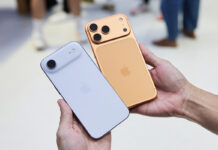![]()
Google comes back for a double encore with its Pixel 2 and Pixel 2 XL smartphones, continuing its penchant for software-driven hardware features.
Last year’s Pixel models were a slight change in direction. Google dropped the Nexus moniker for its branded devices, taking a hands-on approach to the hardware design. A renewed focus on camera performance aimed to put the phones into elite territory with other flagships. The Pixel 2 models are extensions of that focus.
Google Pixel 2 / 2 XLDisplay: 5-inch 1080p HD AMOLED display with 441 pixels per inch |
A very Pixel design
Don’t expect a beauty pageant winner with either the Pixel 2 or Pixel 2 XL. Both carry on the tradition of the previous two with glass in the upper third on the back, and a fingerprint sensor below. The rest of the back is a little more textured to improve gripping, but is neither rubberized nor soft to make the grip overly resistant to heat or sweat. If you’re on the fence about a case, don’t vacillate—you will want to put one on.
As before, Google had manufacturing help. HTC made the Pixel 2, while LG made the Pixel 2 XL. The differences between the two include the screen size, which is 6-inches for the XL and 5-inches for the smaller model. Both displays are OLEDs, albeit from different manufacturers. Being an LG build, the XL has an LG OLED, whereas the smaller Pixel 2 uses an AMOLED panel supplied by Samsung. There are consequences to these design choices I’ll touch on in the next section.
Battery capacity is also different, given the size difference. There’s a noticeable weight disparity, with the larger XL being a heftier 175 grams compared to its smaller sibling’s 141 grams.
Outside of those things, the two are virtually identical. Internal components are the same, as are the cameras, storage capacities, connectivity, water resistance and software. Both run on and showcase Android 8.0 Oreo, and guaranteed for three years’ worth of updates.
Google also opted to completely remove the headphone jack, so the only way to playback audio with a wired connection is to use the adapter that comes in the box. Interestingly, they chose not to include any headphones with the device. The alternative is to use Bluetooth headphones, which are far more common now than even a year or two ago.
Screen issues
A number of reports and articles have highlighted issues related to the Pixel 2 XL’s display, in particular. Some have reported a burn-in effect where the navigation buttons at the bottom appeared as ghosted images. Another noted unresponsive taps on the edges, likely an overzealous feature designed to limit inadvertent taps and swipes when holding the device.
Others complained about the muted colours and tones on the display itself—an unusual attribute for an OLED display.
![]()
Google has acknowledged some of these concerns, stating that software updates would fix the screen burn-in. The unresponsive edges weren’t mentioned as of this review, though that would be an easy adjustment in a software update. The colours were also addressed with a statement saying the screen was made to have “a more natural and accurate rendition” of the sRGB standard.
I didn’t experience any burn-in, nor really noticed response issues with my review units. I did immediately see the lack of vibrancy in the Pixel 2 XL’s display, finding the smaller model to offer a little more pop to colours and images, but I eventually got used to it. Google included a “vivid mode” in the display settings to add a 10% colour boost, which appears to be on by default.
I did notice a bluish tint when tilting the phone to the side. This happened with both devices, though was more noticeable with the XL. OLED screens can skew blue on indirect angles, which isn’t abnormal, though I can see how it might appear off-putting.
![]()
Performance
Despite the subjectivity of the displays, both phones felt like a breeze to use. Fast and responsive, the lighter weight of this Android version makes for a compelling combination of hardware and software.
No matter what I did, be it shooting photos and video, playing games, multitasking, streaming video, listening to music and browsing the web, both phones were smooth throughout. I rarely felt an increase in heat, and never experienced lag or slow performance at anytime, regardless of how much I was packing into either device. To confirm this, I set up both phones identically, testing everything on each phone at the same time.
Android Oreo made this easier, especially with the way it handled video multitasking. Keeping a YouTube video playing while searching something else or responding to a message was the sort of thing that should’ve happened long ago. That it worked with Google Maps was yet another usability tweak that made a lot of sense.
The Pixel 2’s smaller frame simplified one-handed operation. I assume the larger bezels will feel like wasted space, especially when compared to devices like the Essential Phone, which practically sheds all bezels around its display.
Google made each phone’s sides actionable. Squeezing them together triggers Google Assistant, the superb voice platform that can do what a Google Home does, and then some. The one problem is the feature isn’t customizable, meaning you can’t assign a different task to the squeeze.
An interesting addition inside is the eSIM, a built-in SIM that would allow for a distinct cellular connection without a card. This would allow the eSIM to connect to the local network, while a local nano SIM could connect to another one. Ideal for travel and roaming situations, here’s hoping wireless carriers fully embrace it.
![]()
Camera
Bringing in optical image stabilization (OIS) to the rear camera was a necessary hardware adjustment to complement the solid digital stabilization introduced in the previous Pixels. The f/1.8 aperture is nice, helping bring in more light to the 12.2-megapixel image sensor.
The software brings out the best in these components. Apple, Samsung, LG, Huawei and Asus have all gone with dual lenses in the rear, whereas Google decided not to. Some have used the extra optics to help emulate bokeh effects usually seen in DSLR cameras.
Google’s unique use of HDR (high dynamic range) manages to merge multiple images together for optimal exposure, saturation and tonality. It all happens so quickly that you don’t notice it, and it works really well in low-light situations. Some of the best images I’ve ever shot in auto mode on a smartphone were with these two models. Other than adjusting the exposure on the onscreen slider, I only had to point and shoot. The fast focusing also helped capture images quickly.
Portrait mode was especially impressive. The way these phones focused on the foreground subject while blurring the background—and all with one lens—was unlike any other phone I’ve seen. There is a catch though, and that has to do with distance. The further the background, the easier it is for the camera to apply the effect. Asymmetrical backgrounds in closer quarters prove to be more difficult sometimes. There is a blur; it’s just that the effect may be more noticeably pronounced on one side of the photo compared to the other.
You can also apply Portrait mode to the front-facing camera, making selfies a little more dynamic under the right circumstances.
Both Pixel phones have a chip inside called Visual Core SoC that should expand on the HDR capabilities even further. That would include opening them up to third-party developers to use them with their camera apps.
Moreover, Google Photos now uploads images in their original quality for free until 2020. Having 64GB or 128GB for storage options is nice, yet having the cloud help take much of the load from photos and video is a huge benefit. I fired off over 700 photos and videos on a trip to Iceland and never felt concerned about the space they took up.
Music and headphones
The missing headphone jack is going to be a nuisance, possibly aggravated further by the lack of headphones inside the box. The adapter’s inclusion is a no-brainer, and I recommend keeping it attached to your favourite headphones at all times to avoid losing it. Bluetooth is the more convenient option, provided you have, or are getting, a pair of wireless headphones.
Both phones have front-facing stereo speakers, which sound quite good for the limited space they have. I wouldn’t necessarily go watching a full show episode with them, but YouTube videos were fine.
Google’s eventual release of the Pixel Buds will be interesting in how they deal with music and audio. We know that real-time translation will be part of the mix, and I do wonder about other potential features.
One thing that works out of the box is a music discovery mode from the lock screen. The display settings has a feature called “Now Playing” that, when toggled on, will show the song and artist whenever music is playing around you. It can work offline too, provided the song is in the limited database Google has started out with. It’s apparently region-specific too, meaning it will know more about local music when in a specific country.
Some users had complained about phone call quality, but I encountered no issues with that. Callers came through crisply and with no volume issues on either end.
Battery life
I would say battery life is sufficiently good, rather than exceptional. It handles heavy usage well enough to stay on for a full day, but if that is your daily routine, you may be reaching for the charger by bedtime.
The XL’s larger battery tended to last longer because of its larger capacity. I was curious to see how the Pixel 2’s could manage, given its smaller size, and found it be better than expected. Again, in both cases they aren’t amazing, just better than average despite all the stuff you can do with them.
Final thoughts
The issues surrounding these phones casts doubt on them, and I can understand why. People usually perceive flagship devices to be more bulletproof than mid-range or affordable handsets. That neither of these phones is especially beautiful may come across as another negative connotation.
How I felt using them was what stood out more. The trust I had in the camera. The ability to navigate and multitask with nary a concern for performance lag. The lack of range anxiety with internal storage. Three years of guaranteed system and security updates means both phones will eventually be running Android R. How well they’ll do it by that time is hard to gauge, but three years of updates isn’t common for Android phones.
To assess the displays for both phones, I would suggest going in to see them first. Get a sense for how they feel, how the camera shoots and how the system performs. It won’t take long to draw a conclusion.
The Google Pixel 2 and Pixel 2 XL are available now.























